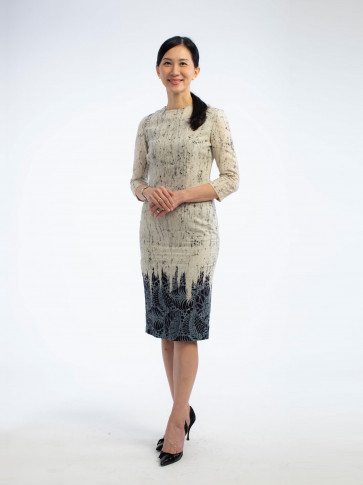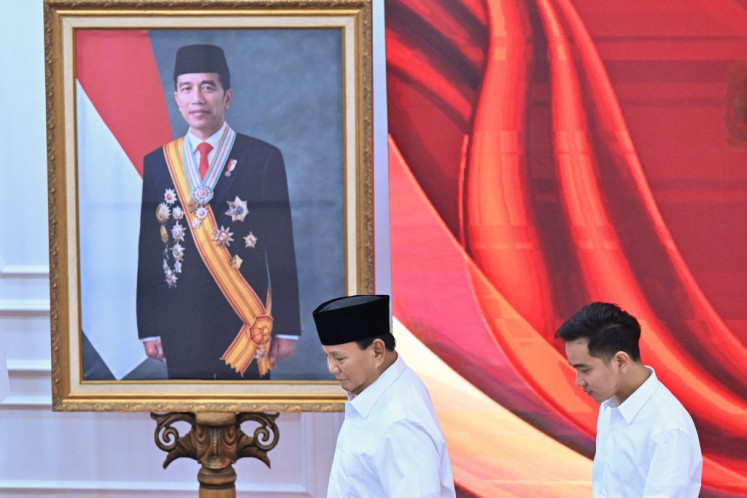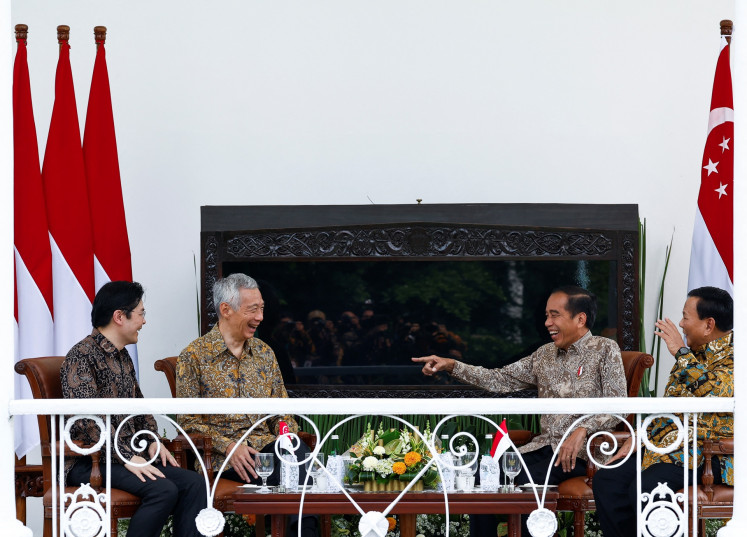Jakarta’s Indo-Pacific agenda gradually takes form in 2018
Middle power: Indian Prime Minister Narendra Modi (left), Indonesian President Joko “Jokowi” Widodo (center) and Japanese Prime Minister Shinzo Abe arrive on stage to pose for a group photo before the start of the 13th East Asia Summit plenary session on the sidelines of the 33rd ASEAN Summit in Singapore in November
Change Size

M
iddle power: Indian Prime Minister Narendra Modi (left), Indonesian President Joko “Jokowi” Widodo (center) and Japanese Prime Minister Shinzo Abe arrive on stage to pose for a group photo before the start of the 13th East Asia Summit plenary session on the sidelines of the 33rd ASEAN Summit in Singapore in November.(AFP/Roslan Rahman)
The year 2018 has seen “Indo-Pacific” reenter the mainstream vernacular of global leaders, governments, security experts and regionalism scholars, many of whom have contributed to a growing body of literature meant to inform on this elusive strategic and geopolitical concept.
Indonesia is no different, having set out a concept that has evolved at a steady pace this year, with an emphasis on ASEAN centrality amid growing uncertainty in the global economy, earmarked by United States-China tensions and a loss of confidence in multilateral structures.
In its current form, the Indo-Pacific is an evolving concept for a vast regional architecture that underpins the area straddling the Indian and Pacific oceans, interpretations of which observers say vary depending on the geopolitical interests of countries in the region.
The term gained traction after US President Donald Trump introduced his vision of a “free and open Indo-Pacific” region during the Asia-Pacific Economic Cooperation (APEC) forum hosted by Vietnam last year.
Around the same time, many other countries also began setting their sights on the region and putting their own spin on the concept. And so India, Australia and South Korea imbued their respective national policies with a new Indo-Pacific focus, and Japan went on a tour of Southeast Asia to promote its own Free and Open Indo-Pacific Strategy, including in Indonesia.
In her annual policy statement in January, Foreign Minister Retno LP Marsudi laid out the country’s vision for the Indo-Pacific, presenting it as regional architecture that provides ample opportunity for ASEAN to take center stage.
Being at the crossroads of the Indian and Pacific oceans, she said Indonesia and other ASEAN member states must become prominent players in the development of this regional architecture, based on existing ASEAN-led mechanisms such as the East Asia Summit (EAS).
From there, the ministry invited officials from Southeast Asian governments and representatives of academic institutions and think tanks to an ASEAN 1.5-track workshop to discuss the need to develop a shared Indo-Pacific agenda.
President Joko “Jokowi” Widodo brought the concept to ASEAN leaders for the first time at the 32nd ASEAN Summit in April, urging member states to strengthen unity and take on a central role in developing the shared framework.
By August, a detailed paper on the Indo-Pacific from Indonesia’s perspective for “an open, transparent and inclusive regional architecture based on international law” was distributed at the ASEAN Ministerial Meeting.
Jokowi then debuted the Indonesia concept at the EAS in November, with a view toward having ASEAN member states adopt a final shared concept of the Indo-Pacific next year.
In an interview with The Jakarta Post earlier this month, Minister Retno said the President had essentially linked the Indo-Pacific concept with his own Global Maritime Fulcrum vision that he debuted at the same forum four years earlier.
“There is a link, [...] a common thread in which the emphasis of the Indo-Pacific concept is cooperation in the maritime field,” she told the Post.
The East Asia Summit — a forum that gathers 10 ASEAN member states and Australia, China, India, Japan, New Zealand, South Korea, Russia, as well as the US — was suddenly envisioned as the most suitable ASEAN-led mechanism to realize the Indo-Pacific concept.
Over the past year, Retno brought Indonesia’s version of the concept to various engagements with her foreign counterparts, especially those who have or are gaining a foothold in the region (like China), to garner support for an inclusive and ASEAN-led Indo-Pacific strategy.
Retno said since Indonesia had developed its own concept and introduced it to ASEAN, it also kept itself open to input from key countries in the region such as Australia, the US, Japan, South Korea, India, Russia, New Zealand and China, “so that everyone is comfortable with the concept”.
Indonesia’s lead diplomat on ASEAN affairs, Jose Tavares, gave assurances that even among ASEAN member states, the Indo-Pacific concept that was to be agreed upon would be one that all ASEAN nations could get behind.
“We are able to have it [for] ourselves without having others tell us what to do,” he said this month.
“After all, Indonesia was the first to come up with the Indo-Pacific concept. In 2013, Pak Marty [Natalegawa, the country’s previous foreign minister] came up with the idea of the Indo-Pacific. So we are continuing [his legacy] even though we have to make adjustments to reflect on the current situation, as geopolitics have changed.”
However, in spite of her optimism that countries would eventually gather around ASEAN, the foreign minister said she was prepared to play the long game in anticipation for a concept as big as the Indo-Pacific, with progress expected to be slow and gradual.
“It cannot be forced because our basic concept is inclusive, meaning that there are key players in the Indo-Pacific region that must be involved,” she said.
Coined in the last decade by some accounts, the concept was informed by what some experts called the eastward shift of the world’s economic “center of gravity” toward the Asian continent.
Another reading of the Indo-Pacific toys with the idea of the growing eminence of India, and that the long-prevalent “Asia-Pacific” construct was not enough to represent New Delhi’s new role.
Observers from the West have also said the concept aims to contain China’s meteoric rise as an emerging superpower in the region, but Indonesia chose instead to include China in developing the framework.
“Indonesia’s concept clearly places ASEAN at the center, and this has been true right from the very beginning. And in time it became clear that all the parties we invited to speak had come out to support ASEAN centrality,” Retno said.
“With ASEAN centrality, it is easier for us to form the building blocks [for the Indo-Pacific] because we have already done a lot of cooperation within ASEAN.”
Dewi Fortuna Anwar, a research professor at the Indonesian Institute of Sciences’ Center for Political Studies, made a case for ASEAN’s central role in the Indo-Pacific.
“If the tension between superpower countries intensify, on one side it creates more problems, […] but on the other side it makes ASEAN more relevant because there is no other place for them to meet other than in a neutral place,” Dewi told the Post recently.
With ASEAN already the primary convener of regional meetings, she said the organization was in a good position to make use of the many mechanisms it had to bring its partners together.
“Basically, ASEAN is a large event organizer,” Dewi said.
Indonesia has highlighted a number of existing ASEAN programs that could be worked into a wider Indo-Pacific strategy, such as the Master Plan on ASEAN Connectivity and the 2025 ASEAN Community Vision.
Even so, more work remains for ASEAN, as it seeks to complete the Indo-Pacific strategy by connecting its traditional sphere of influence in the Pacific Ocean with possible partners in the Indian Ocean.
For Retno, it was therefore necessary for Indonesia to introduce the concept to the Indian Ocean Rim Association (IORA), as it was the only organization to govern over countries in that entire region.
To this end, Indonesia plans to host the Indo-Pacific Maritime Dialogue next year to provide an opportunity for IORA to partner up with ASEAN. Plans are also under way for ASEAN to engage with the Pacific Islands Forum (PIF) for countries in the South Pacific, and the APEC forum, the Asia-Pacific (or rather Indo-Pacific) region’s premier economic platform.
Jose, the ministry’s director general for ASEAN cooperation, said the organization had gained the trust of its many partners in promoting its inclusive Indo-Pacific concept, mainly because it did not take sides in existing geopolitical and strategic rivalries, which experts were concerned might find a way into the final concept.
“So we need to come up with our own outlook, insights and strategies,” he said.
“Right now, there are countries that are lining up to be ASEAN’s partners. We’re like a beautiful girl and everyone wants to give us a gift.”









